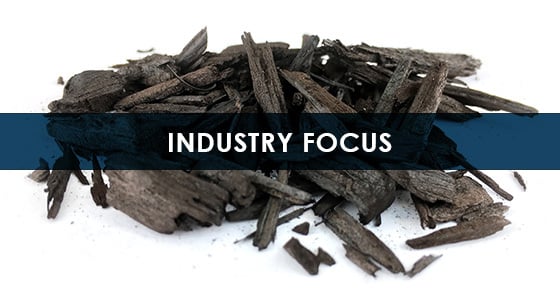A new study published in the journal GCB-Bioenergy could be a significant finding for the agriculture industry and beyond. In Water Cost Savings from Soil Biochar Amendment: A Spatial Analysis, scientists reveal how adding biochar to sandy soils could substantially reduce irrigation requirements.
In addition to having major implications on world food production in the face of dwindling water resources and increasing drought events, the finding could provide a major cost savings to farmers.
The study is one more step on the ladder toward a stronger market and more commercialized biochar production.
What the Biochar Study Reveals
In addition to uncovering in more detail exactly how biochar characteristics affect soil water management, the authors wanted to illustrate the financial benefits farmers could reap from a biochar soil amendment, as these have largely been left behind by research up to this point.
The impact on farmers, the authors note, is particularly important, as they are ultimately the ones who decide what inputs their soil receives.
By measuring changes in water holding capacity (WHC) in relation to biochar properties, application rates, and soil texture, and then mapping results against US counties, researchers were able to apply an economic model to estimate irrigation requirements in response to biochar application. The results were astounding: a potential 37.9% reduction in the amount of irrigation water needed.
How this translates into actual cost for farmers is complicated, as it depends on a number of farm- and region-specific factors, such as labor, water, and energy costs, among others.
The study focused on sandy soils, due to a lack of data on other soil types. The authors note, however, that because higher sand content was associated with a greater increase of water holding capacity, biochar application would be especially beneficial in areas with sandy soils, such as the southeast, far north and northeast, and western United States. Additional research is needed on other soil types.
While application rates for the study were higher than traditional application rates, the estimated savings do not take into account the many other cost savings farmers could realize through biochar application as a result of its other benefits to soil. Additional potential costs savings could come from:
- Lower nitrogen input requirements
- Higher crop yields due to lower plant stress
- Decreased requirement of pesticides as a result of more resilient plants
The Mechanism Behind Biochar’s Water Retention Capabilities
The reduced requirement for irrigation water is a result of the increased water holding capacity soils achieved with biochar. This change, according to the study, is primarily a result of the packing efficiency of soil particles, making biochar particle size an influential factor.
Researchers found that WHC is increased when new pore spaces are created in the soil, with biochar particles of a different diameter (from soil) and shaped narrow and long being the most effective. Additional WHC is gained as a result of the internal pore structure of the biochar particles.
Biochar is produced via a thermal processing technique known as pyrolysis. In a pyrolysis kiln, temperature, retention time, processing atmosphere, and additional criteria are tightly controlled to produce a product with the desired qualities.
The authors found application rate, particle size, soil texture, and type of feedstock pyrolyzed were influential in the WHC increase, with non-grassy feedstocks actually having a negative impact on WHC. The pyrolysis temperature did not seem to have an effect.
Benefits of Biochar as a Soil Amendment Beyond the Farmer
While the study reveals the potential benefits to farmers, it’s important to recognize the greater implications of the findings as well.
Water Conservation
Water is a critical and dwindling resource. Currently, agriculture accounts for a whopping 80% of water use in the US, making efficient water management a key focus of sustainably meeting the growing demand for global food requirements.
Further, as extreme climate events persist, crops will need to become more resilient as they struggle with not enough or too much water. Not surprisingly, water management will be especially critical in drought-prone regions.
Considering these factors, the ability to maximize water conservation has never been more important.
Reduced Runoff
An improved WHC means that any applied water (via rainfall or irrigation) is better retained in soil. Not only does this result in less required irrigation water, but it also means that less water (and therefore nutrients) will run off.
Nutrient runoff has been a growing issue in recent years as its effects become more evident and increasingly severe, such as in the creation of ‘dead zones’ in water bodies. Any reduction in nutrient runoff is a welcome addition to the fight.
A reduction in runoff also means that nutrient use is more efficient, and plants can take advantage of more of the nutrients farmers apply instead of them going to waste.
Carbon Capture
The aforementioned concepts have major implications to life on earth, but that is to say nothing of biochar’s ability to trap carbon. Biochar is under investigation for use as a potential carbon sink in the fight against greenhouse gas emissions.
Conclusion
The evidence for using biochar as a soil amendment is mounting, with the latest showing that farmers could realize cost savings through use of the carbon-based product. While more research on the topic is still needed, biochar looks to be especially beneficial for sandy soils such as those found throughout the US.
FEECO offers a unique process development facility for testing biochar production in batch and pilot kilns, as well as biochar agglomeration for use as a soil amendment (or other application). We use the data gathered during testing to engineer custom pyrolysis kilns for commercial biochar production. For more information on our testing services or rotary kilns, contact us today!
SOURCE:
https://onlinelibrary.wiley.com/doi/abs/10.1111/gcbb.12765



